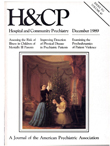Characteristics and Behavior of Patients Involved in Psychiatric Ward Incidents
Abstract
Although psychiatric diagnosis cannot effectively predict incidents except assaults, patient behavior patterns may be valuable for predicting the type of incident for which a patient might be vulnerable. When a patient, particularly a young male, becomes hyperactive, loud, and hostile, it is imperative to control the behavior with pharmacological on other means to avert potential violence. If a depressed patient, particularly a middle-aged woman, shows a significant level of anxiety and apprehension, it is important to observe the patient closely with continuing reassurance to prevent a potential suicide attempt. When a patient becomes markedly withdrawn, lethargic, and confused, a vigorous medical assessment is warranted to provide timely treatment for potentially life-threatening medical conditions. Thus careful monitoring of patients' behavior can direct staff members in the necessary precautions to take to prevent potential incidents.
Access content
To read the fulltext, please use one of the options below to sign in or purchase access.- Personal login
- Institutional Login
- Sign in via OpenAthens
- Register for access
-
Please login/register if you wish to pair your device and check access availability.
Not a subscriber?
PsychiatryOnline subscription options offer access to the DSM-5 library, books, journals, CME, and patient resources. This all-in-one virtual library provides psychiatrists and mental health professionals with key resources for diagnosis, treatment, research, and professional development.
Need more help? PsychiatryOnline Customer Service may be reached by emailing [email protected] or by calling 800-368-5777 (in the U.S.) or 703-907-7322 (outside the U.S.).



